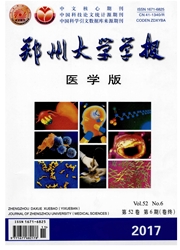

 中文摘要:
中文摘要:
目的:寻找转化抗菌氟喹诺酮到抗肿瘤氟喹诺酮的有效策略。方法:用酰腙作为N-甲基环丙沙星C-3羧基的生物电子等排体,合成了12个环丙沙星酰腙目标化合物,其结构经元素分析和光谱数据确证。用MTT方法评价了目标化合物体外对SMMC-7721、L1210和HL603种癌细胞的生长抑制活性。结果:酰腙目标物对3种实验癌细胞的生长抑制活性显著强于母体环丙沙星。构-效关系表明,苯环带吸电子化合物的活性强于供电子化合物的活性,尤其带羧基和磺酰胺基化合物的活性强于其他取代基化合物的活性。结论:氟喹诺酮C-3羧基并非是抗肿瘤活性所必需的药效团,被酰腙取代可提高其抗肿瘤活性。
 英文摘要:
英文摘要:
Aim:To explore an efficient strategy for a transformation of antibacterial fluoroquinolone into antitumor flu -oroquinolones .Methods:An acylhydrazone used as bioisostere of the C-3 carboxylic group ,twelve novel fluoroquinolone C-3 acylhydrazones were synthesized from ciprofloxacin ,respectively .The structures of the title compounds were characterized by elemental analysis and spectral data , and the in vitro antitumor activity against SMMC-7721 , L1210 and HL60 cells were also evaluated by MTT assay .Results: The title compounds exhibited more significantly inhibitory activity than the parent.The SAR showed that some title compounds with electron-withdrawing groups had more potent cytotoxicity than that of compounds with electron-donating group .In particular , some compounds bearing carboxylic group and sulfonamide group had better activity than other title compounds .Conclusion:It appears to be not necessary for the C-3 carboxylic group to develop antitumor fluoroquinolones ,and the bioisosteric replacement with a acylhydrazone group could improve the antitumor activity.
 同期刊论文项目
同期刊论文项目
 同项目期刊论文
同项目期刊论文
 Part II: Design, synthesis and antitumor action of C3/C3 bis-fluoroquinolones linked-cross 2,5-[1,3,
Part II: Design, synthesis and antitumor action of C3/C3 bis-fluoroquinolones linked-cross 2,5-[1,3, Synthesis and antitumor evaluation of fluoroquinolone C3 fused heterocycles (II): From triazolothiad
Synthesis and antitumor evaluation of fluoroquinolone C3 fused heterocycles (II): From triazolothiad Design, synthesis and antitumor activity of C3/C3 bis- fluoroquinolones cross-linked with [1,2,4]tri
Design, synthesis and antitumor activity of C3/C3 bis- fluoroquinolones cross-linked with [1,2,4]tri Synthesis and antitumor evaluation of C3/C3 fluoroquinolone dimmers (I): Tethered with a fused heter
Synthesis and antitumor evaluation of C3/C3 fluoroquinolone dimmers (I): Tethered with a fused heter Design, synthesis and antitumor activity of C-3/C-3 bis-fluoroquinolones cross-linked with [1,24]tri
Design, synthesis and antitumor activity of C-3/C-3 bis-fluoroquinolones cross-linked with [1,24]tri 期刊信息
期刊信息
